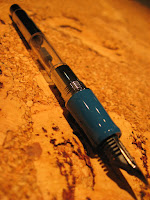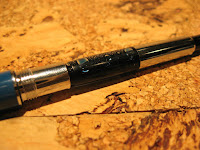 I acquired a Pilot Custom Heritage 91 fountain pen several months ago, but haven't had the time to write about it until now. At the time of acquisition, I really wanted to try a good Japanese nib, and I had my eye on the Pilot Prera fountain pen. After doing some research and over-analysis, however, my eye started to wander over to the higher quality Pilot pens, such as the Custom 74, the Custom 823, and the Custom Heritage 92. I accidentally learned about the Custom Heritage 91 model while reading up on the other Pilot models (the 91 is not readily available in the United States and there isn't a lot of published information about it). Long story short, I ordered one (in the Tsuki-Yo colorway) from a Japanese vendor, and am pleased to say the least. As the picture indicates, the nib is a 14 karat rhodium plated variety. I opted for a fine sized nib, assuming that it would write lines having a thickness similar to my Lamy extra fine and my Pelikan extra fine.
I acquired a Pilot Custom Heritage 91 fountain pen several months ago, but haven't had the time to write about it until now. At the time of acquisition, I really wanted to try a good Japanese nib, and I had my eye on the Pilot Prera fountain pen. After doing some research and over-analysis, however, my eye started to wander over to the higher quality Pilot pens, such as the Custom 74, the Custom 823, and the Custom Heritage 92. I accidentally learned about the Custom Heritage 91 model while reading up on the other Pilot models (the 91 is not readily available in the United States and there isn't a lot of published information about it). Long story short, I ordered one (in the Tsuki-Yo colorway) from a Japanese vendor, and am pleased to say the least. As the picture indicates, the nib is a 14 karat rhodium plated variety. I opted for a fine sized nib, assuming that it would write lines having a thickness similar to my Lamy extra fine and my Pelikan extra fine.Although I was a little paranoid about ordering something from a Japanese website, the experience was painless and the pen arrived safely and with little overseas delay. The pen came packaged in a simple box, with one complimentary Pilot ink cartridge. Nice package, but I would have been OK with a plain cardboard box and a lower price.
I also ordered a Pilot CON-70 converter for the pen; the CON-70 employs a cool button vacuum mechanism that literally sucks in the ink. It's actually somewhat fun to use the CON-70. Really.
 |
| CON-70: Before Filling |
 |
| CON-70: After Filling |
I already had a sample of the Tsuki-Yo ink waiting for the pen, and it was nice to try the ink for the first time using its matching pen. I recently bought a full bottle of the Tsuki-Yo ink and plan to keep the 91 loaded with it. Pilot did a great job at matching the pen color to the ink. The white balance and lighting used in my pictures may not depict how close the colors are, but in reality they are very close (especially when good white paper is used).
So what about the pen itself? It's a great pen. The nib is high quality and it writes very smoothly but with some "toothy" feedback due to the fact that it is a Japanese fine sized nib. It always starts right up, it flows nicely, and doesn't skip. It has a little bit of give to it, but it is not as springy as the extra fine nib on my Pelikan M205. Take a look at the first picture above, the rhodium plating and design of the nib is top notch. The silver trim on the body is also very nice; I really prefer silver trim to the gold trim found on many traditional pens.
The size, shape, and weight of the pen work well for me. It's a little on the light side, but I don't mind (it weighed in at 22.2 grams, including the cap, with the converter nearly full of ink). I can comfortably use the pen with the cap posted or unposted. I really like the "plain" traditional design of the pen, including the monotone colorway that carries through to the grip section. Stay classy.
FYI, good reviews and better pictures of this pen can be found here (The Pen Addict) and here (Leigh Reyes).
I'll end this post with some writing samples on different types of paper. Each sample was written using the Pilot Custom Heritage 91 pen, with the matching Pilot Iroshizuku Tsuki-Yo ink. I tried to size, crop, and combine all of the images together for the sake of comparison. The image really shows how the the line width, feathering, and the color of the ink vary depending on the type/quality of paper. The images are ordered (top to bottom) from best to worst results, in my opinion. Rhodia Dot Pad = A; Moleskine Notebook = D.




